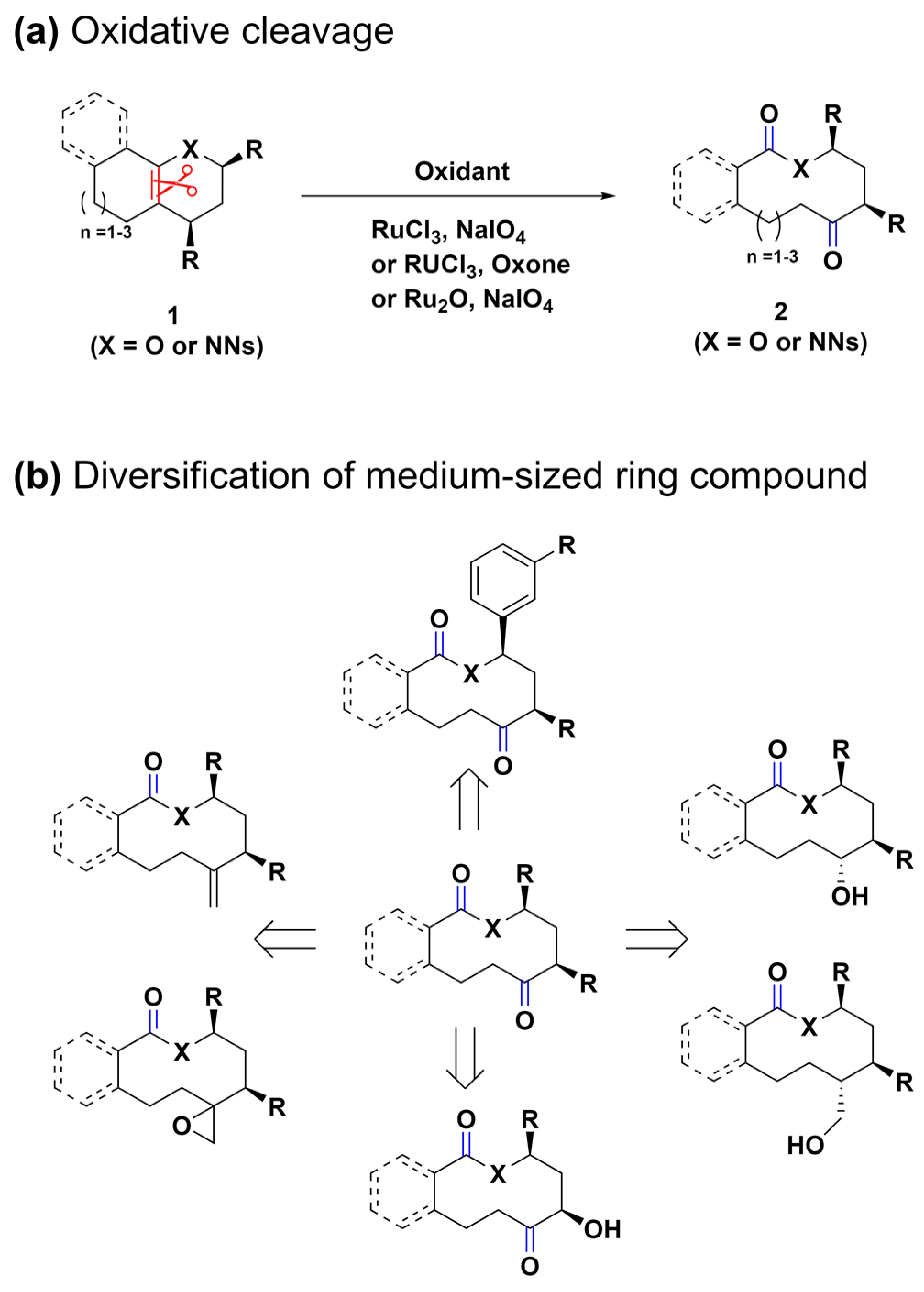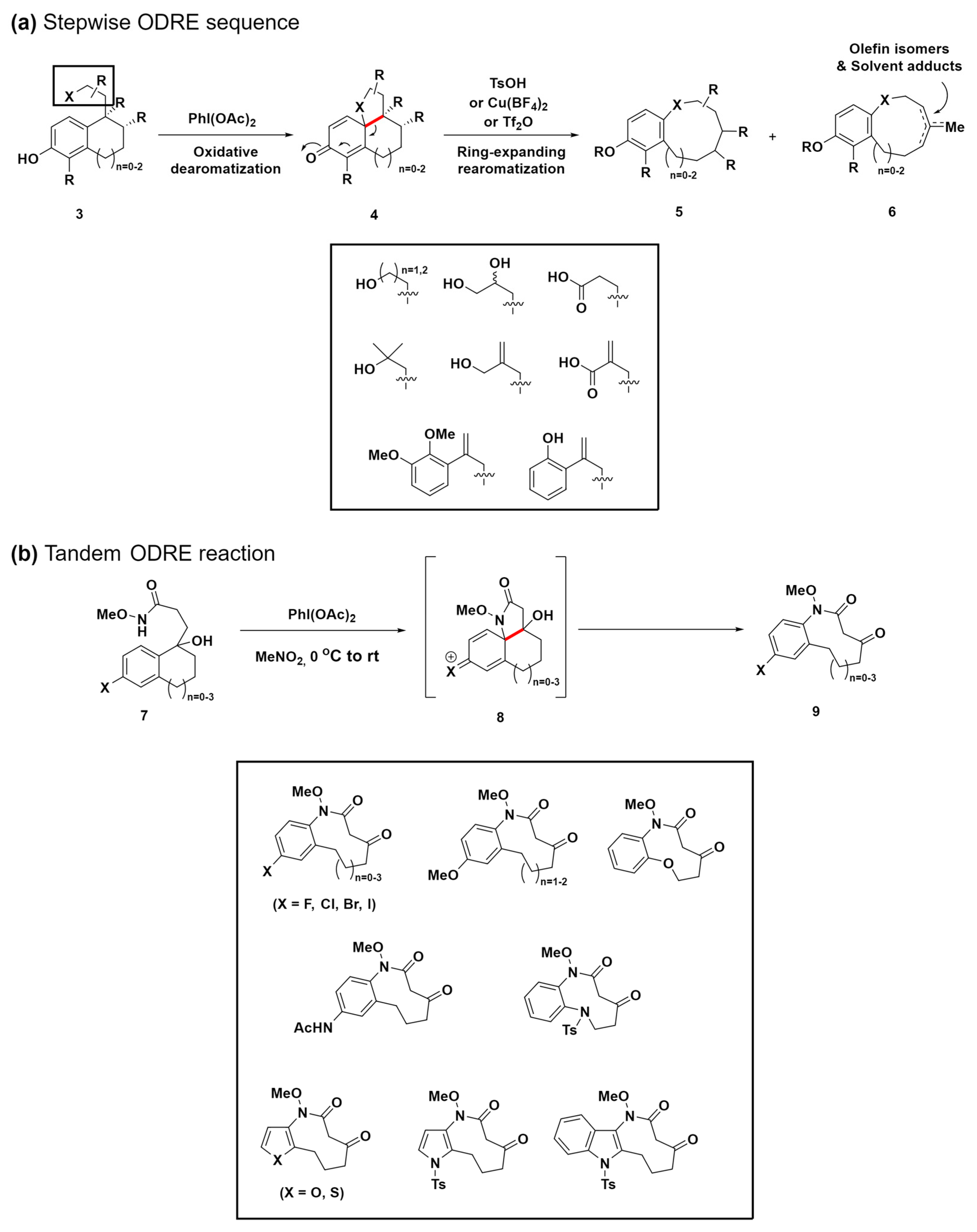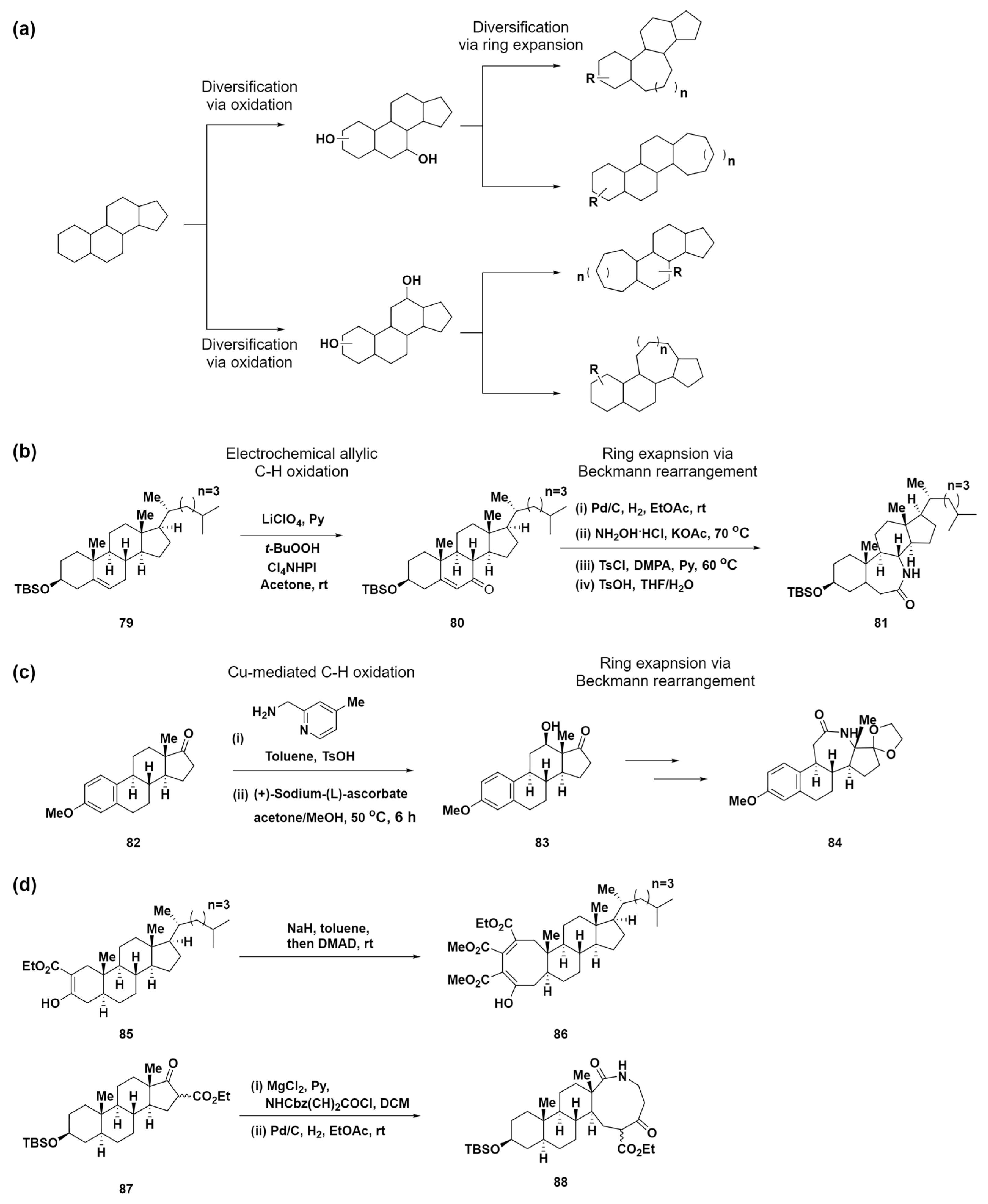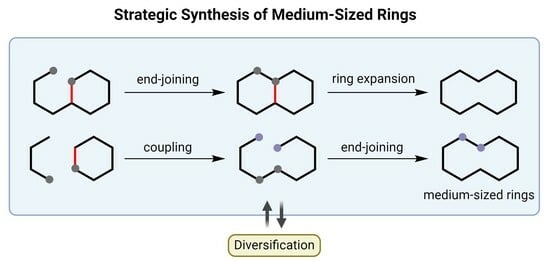Medium-Sized Ring Expansion Strategies: Enhancing Small-Molecule Library Development
Abstract
1. Introduction

2. Ring-Expansion Reactions via the Cleavage of the C–C Bond for the Synthesis of Medium-Sized Rings
3. Ring-Expansion Reactions via the Cleavage of the N–N Bond for the Synthesis of Medium-Sized Rings
4. Ring-Expansion Reactions via the Cleavage of the C–N Bond for the Synthesis of Medium-Sized Rings
5. Ring-Expansion Strategies for Synthesizing Complex Natural-Product-like Molecules with Medium-Sized Rings
6. Conclusions
Author Contributions
Funding
Institutional Review Board Statement
Informed Consent Statement
Data Availability Statement
Conflicts of Interest
References
- Atanasov, A.G.; Zotchev, S.B.; Dirsch, V.M.; Supuran, C.T.; Taskforce, I.N.P.S. Natural products in drug discovery: Advances and opportunities. Nat. Rev. Drug Discov. 2021, 20, 200–216. [Google Scholar] [CrossRef] [PubMed]
- Barba-Ostria, C.; Carrera-Pacheco, S.E.; Gonzalez-Pastor, R.; Heredia-Moya, J.; Mayorga-Ramos, A.; Rodríguez-Pólit, C.; Zúñiga-Miranda, J.; Arias-Almeida, B.; Guamán, L.P. Evaluation of biological activity of natural compounds: Current trends and methods. Molecules 2022, 27, 4490. [Google Scholar] [CrossRef] [PubMed]
- Wilson, B.A.P.; Thornburg, C.C.; Henrich, C.J.; Grkovic, T.; O’Keefe, B.R. Creating and screening natural product libraries. Nat. Prod. Rep. 2020, 37, 893–918. [Google Scholar] [CrossRef] [PubMed]
- Schreiber, S.L. Organic chemistry: Molecular diversity by design. Nature 2009, 457, 153–154. [Google Scholar] [CrossRef] [PubMed]
- Burke, M.D.; Schreiber, S.L. A planning strategy for diversity-oriented synthesis. Angew. Chem. Int. Ed. 2004, 43, 46–58. [Google Scholar] [CrossRef] [PubMed]
- Schreiber, S.L. Target-oriented and diversity-oriented organic synthesis in drug discovery. Science 2000, 287, 1964–1969. [Google Scholar] [CrossRef] [PubMed]
- Galloway, W.R.J.D.; Isidro-Llobet, A.; Spring, D.R. Diversity-oriented synthesis as a tool for the discovery of novel biologically active small molecules. Nat. Commun. 2010, 1, 80. [Google Scholar] [CrossRef]
- Gerry, C.J.; Schreiber, S.L. Chemical probes and drug leads from advances in synthetic planning and methodology. Nat. Rev. Drug Discov. 2018, 17, 333–352. [Google Scholar] [CrossRef] [PubMed]
- Garcia-Castro, M.; Zimmermann, S.; Sankar, M.G.; Kumar, K. Scaffold diversity synthesis and its application in probe and drug discovery. Angew. Chem. Int. Ed. 2016, 55, 7586–7605. [Google Scholar] [CrossRef]
- Lenci, E.; Trabocchi, A. Diversity-oriented synthesis and chemoinformatics: A fruitful synergy towards better chemical libraries. Eur. J. Org. Chem. 2022, 2022, e202200575. [Google Scholar] [CrossRef]
- Kato, N.; Comer, E.; Sakata-Kato, T.; Sharma, A.; Sharma, M.; Maetani, M.; Bastien, J.; Brancucci, N.M.; Bittker, J.A.; Corey, V.; et al. Diversity-oriented synthesis yields novel multistage antimalarial inhibitors. Nature 2016, 538, 344–349. [Google Scholar] [CrossRef] [PubMed]
- Huigens, R.W.; Morrison, K.C.; Hicklin, R.W.; Flood, T.A.; Richter, M.F.; Hergenrother, P.J. A ring-distortion strategy to construct stereochemically complex and structurally diverse compounds from natural products. Nat. Chem. 2013, 5, 195–202. [Google Scholar] [CrossRef] [PubMed]
- Rafferty, R.J.; Hicklin, R.W.; Maloof, K.A.; Hergenrother, P.J. Synthesis of complex and diverse compounds through ring distortion of abietic acid. Angew. Chem. Int. Ed. 2014, 53, 220–224. [Google Scholar] [CrossRef] [PubMed]
- Llabani, E.; Hicklin, R.W.; Lee, H.Y.; Motika, S.E.; Crawford, L.A.; Weerapana, E.; Hergenrother, P.J. Diverse compounds from pleuromutilin lead to a thioredoxin inhibitor and inducer of ferroptosis. Nat. Chem. 2019, 11, 521–532. [Google Scholar] [CrossRef] [PubMed]
- Furiassi, L.; Tonogai, E.J.; Hergenrother, P.J. Limonin as a starting point for the construction of compounds with high scaffold diversity. Angew. Chem. Int. Ed. 2021, 60, 16119–16128. [Google Scholar] [CrossRef] [PubMed]
- Paciaroni, N.G.; Perry, D.L.; Norwood, V.M.; Murillo-Solano, C.; Collins, J.; Tenneti, S.; Chakrabarti, D.; Huigens, R.W. Re-engineering of yohimbine’s biological activity through ring distortion: Identification and structure-activity relationships of a new class of antiplasmodial agents. ACS Infect. Dis. 2020, 6, 159–167. [Google Scholar] [CrossRef] [PubMed]
- Seong, S.; Lim, H.; Han, S. Biosynthetically inspired transformation of iboga to monomeric post-iboga alkaloids. Chem 2019, 5, 353–363. [Google Scholar] [CrossRef]
- Mizoguchi, H.; Oikawa, H.; Oguri, H. Biogenetically inspired synthesis and skeletal diversification of indole alkaloids. Nat. Chem. 2014, 6, 57–64. [Google Scholar] [CrossRef]
- Yang, Y.; Bai, Y.; Sun, S.; Dai, M. Biosynthetically inspired divergent approach to monoterpene indole alkaloids: Total synthesis of mersicarpine, leuconodines B and D, leuconoxine, melodinine E, leuconolam, and rhazinilam. Org. Lett. 2014, 16, 6216–6219. [Google Scholar] [CrossRef]
- Bao, R.Y.; Zhang, H.Y.; Tang, Y.F. Biomimetic synthesis of natural products: A journey to learn, to mimic, and to be better. Acc. Chem. Res. 2021, 54, 3720–3733. [Google Scholar] [CrossRef]
- Svenda, J.; Sheremet, M.; Kremer, L.; Maier, L.; Bauer, J.O.; Strohmann, C.; Ziegler, S.; Kumar, K.; Waldmann, H. Biology-oriented synthesis of a withanolide-inspired compound collection reveals novel modulators of hedgehog signaling. Angew. Chem. Int. Ed. 2015, 54, 5596–5602. [Google Scholar] [CrossRef]
- Yasir, A.; Ishtiaq, S.; Jahangir, M.; Ajaib, M.; Salar, U.; Khan, K.M. Biology-oriented synthesis (BIOS) of piperine derivatives and their comparative analgesic and antiinflammatory activities. Med. Chem. 2018, 14, 269–280. [Google Scholar] [CrossRef]
- Wilk, W.; Zimmermann, T.J.; Kaiser, M.; Waldmann, H. Principles, implementation, and application of biology-oriented synthesis (BIOS). Biol. Chem. 2010, 391, 491–497. [Google Scholar] [CrossRef] [PubMed]
- Karageorgis, G.; Waldmann, H. Guided by evolution: Biology-oriented synthesis of bioactive compound classes. Synthesis 2019, 51, 55–66. [Google Scholar] [CrossRef]
- Cremosnik, G.S.; Liu, J.; Waldmann, H. Guided by evolution: From biology oriented synthesis to pseudo natural products. Nat. Prod. Rep. 2020, 37, 1497–1510. [Google Scholar] [CrossRef] [PubMed]
- Karageorgis, G.; Foley, D.J.; Laraia, L.; Brakmann, S.; Waldmann, H. Pseudo Natural Products-Chemical Evolution of Natural Product Structure. Angew. Chem. Int. Ed. 2021, 60, 15705–15723. [Google Scholar] [CrossRef] [PubMed]
- Grigalunas, M.; Brakmann, S.; Waldmann, H. Chemical Evolution of Natural Product Structure. J. Am. Chem. Soc. 2022, 144, 3314–3329. [Google Scholar] [CrossRef] [PubMed]
- Kim, J.; Kim, H.; Park, S.B. Privileged structures: Efficient chemical “navigators” toward unexplored biologically relevant chemical spaces. J. Am. Chem. Soc. 2014, 136, 14629–14638. [Google Scholar] [CrossRef]
- Kim, J.; Jung, J.; Koo, J.; Cho, W.; Lee, W.S.; Kim, C.; Park, W.; Park, S.B. Diversity-oriented synthetic strategy for developing a chemical modulator of protein-protein interaction. Nat. Commun. 2016, 7, 13196–13205. [Google Scholar] [CrossRef]
- Kim, H.; Tung, T.T.; Park, S.B. Privileged substructure-based diversity-oriented synthesis pathway for diverse pyrimidine-embedded polyheterocycles. Org. Lett. 2013, 15, 5814–5817. [Google Scholar] [CrossRef]
- Shin, Y.H.; Cho, H.N.; Choi, B.Y.; Kim, J.; Ha, J.; Suh, S.W.; Park, S.B. Phenotypic discovery of neuroprotective agents by regulation of tau proteostasis via stress-responsive activation of PERK signaling. Angew. Chem. Int. Ed. 2021, 60, 1831–1838. [Google Scholar] [CrossRef] [PubMed]
- Lee, S.; Nam, Y.; Koo, J.Y.; Lim, D.; Park, J.; Ock, J.; Kim, J.; Suk, K.; Park, S.B. A small molecule binding HMGB1 and HMGB2 inhibits microglia-mediated neuroinflammation. Nat. Chem. Biol. 2014, 10, 1055–1060. [Google Scholar] [CrossRef] [PubMed]
- Cho, W.; Won, S.; Choi, Y.; Yi, S.; Park, J.B.; Park, J.G.; Kim, C.E.; Narayana, C.; Kim, J.H.; Yim, J.; et al. Targeted protein upregulation of STING for boosting the efficacy of immunotherapy. Angew. Chem. Int. Ed. 2023, 62, e202300978. [Google Scholar] [CrossRef] [PubMed]
- Shin, Y.H.; Jeong, K.; Lee, J.; Lee, H.J.; Yim, J.; Kim, J.; Kim, S.; Park, S.B. Inhibition of ACE2-Spike interaction by an ACE2 binder suppresses SARS-CoV-2 entry. Angew. Chem. Int. Ed. 2022, 61, e202115695. [Google Scholar] [CrossRef] [PubMed]
- Hu, Y.-J.; Li, L.-X.; Han, J.-C.; Min, L.; Li, C.-C. Recent advances in the total synthesis of natural products containing eight-membered carbocycles (2009–2019). Chem. Rev. 2020, 120, 5910–5953. [Google Scholar] [CrossRef] [PubMed]
- Noor, R.; Zahoor, A.F.; Mansha, A.; Khan, S.G.; Haq, A.U.; Ahmad, S.; Al-Hussain, S.A.; Irfan, A.; Zaki, M.E.A. Synthetic potential of regio- and stereoselective ring expansion reactions of six-membered carbo- and heterocyclic ring systems: A review. Int. J. Mol. Sci. 2023, 24, 6692. [Google Scholar] [CrossRef] [PubMed]
- Zhang, J.; Wu, J.; Hong, B.; Ai, W.; Wang, X.; Li, H.; Lei, X. Diversity-oriented synthesis of lycopodium alkaloids inspired by the hidden functional group pairing pattern. Nat. Commun. 2014, 5, 4614. [Google Scholar] [CrossRef] [PubMed][Green Version]
- Spring, D.R.; Krishnan, S.; Schreiber, S.L. Towards diversity-oriented, stereoselective syntheses of biaryl- or bis(aryl)metal-containing medium rings. J. Am. Chem. Soc. 2000, 122, 5656–5657. [Google Scholar] [CrossRef]
- Spring, D.R.; Krishnan, S.; Blackwell, H.E.; Schreiber, S.L. Diversity-oriented synthesis of biaryl-containing medium rings using a one bead/one stock solution platform. J. Am. Chem. Soc. 2002, 124, 1354–1363. [Google Scholar] [CrossRef]
- Reyes, R.L.; Iwai, T.; Sawamura, M. Construction of medium-sized rings by gold catalysis. Chem. Rev. 2021, 121, 8926–8947. [Google Scholar] [CrossRef]
- Hussain, A.; Yousuf, S.K.; Mukherjee, D. Importance and synthesis of benzannulated medium-sized and macrocyclic rings (BMRs). RSC Adv. 2014, 4, 43241–43257. [Google Scholar] [CrossRef]
- Burevschi, E.; Pena, I.; Sanz, M.E. Medium-sized rings: Conformational preferences in cyclooctanone driven by transannular repulsive interactions. Phys. Chem. Chem. Phys. 2019, 21, 4331–4338. [Google Scholar] [CrossRef] [PubMed]
- Biletskyi, B.; Colonna, P.; Masson, K.; Parrain, J.L.; Commeiras, L.; Chouraqui, G. Small rings in the bigger picture: Ring expansion of three- and four-membered rings to access larger all-carbon cyclic systems. Chem. Soc. Rev. 2021, 50, 7513–7538. [Google Scholar] [CrossRef] [PubMed]
- Molander, G.A. Diverse methods for medium ring synthesis. Acc. Chem. Res. 1998, 31, 603–609. [Google Scholar] [CrossRef]
- Majhi, T.P.; Achari, B.; Chattopadhyay, P. Advances in the synthesis and biological perspectives of benzannulated medium ring heterocycles. Heterocycles 2007, 71, 1011–1052. [Google Scholar] [CrossRef]
- Liu, S.; Ma, P.; Zhang, L.; Shen, S.; Miao, H.J.; Liu, L.; Houk, K.N.; Duan, X.H.; Guo, L.N. A cheap metal catalyzed ring expansion/cross-coupling cascade: A new route to functionalized medium-sized and macrolactones. Chem. Sci. 2023, 14, 5220–5225. [Google Scholar] [CrossRef]
- Kalinin, S.; Sapegin, A. Ring Expansion Reactions through Intramolecular Transamidation. Eur. J. Org. Chem. 2023, 26, e202300754. [Google Scholar] [CrossRef]
- Delporte, C.; Backhouse, N.; Negrete, R.; Gallardo, M.C.; Rivera, P. Antiinflammatory and antipyretic activities of spartidienedione isolated from Psila spartioides. Int. J. Pharmacogn. 1996, 34, 179–183. [Google Scholar] [CrossRef]
- Sirindil, F.; Weibel, J.M.; Pale, P.; Blanc, A. Rhazinilam-leuconolam family of natural products: A half century of total synthesis. Nat. Prod. Rep. 2022, 39, 1574–1590. [Google Scholar] [CrossRef]
- Urda, C.; Fernandez, R.; Perez, M.; Rodriguez, J.; Jimenez, C.; Cuevas, C. Protoxenicins A and B, cytotoxic long-chain acylated xenicanes from the soft coral Protodendron repens. J. Nat. Prod. 2017, 80, 713–719. [Google Scholar] [CrossRef]
- Negrin, G.; Eiroa, J.L.; Morales, M.; Triana, J.; Quintana, J.; Estevez, F. Naturally occurring asteriscunolide A induces apoptosis and activation of mitogen-activated protein kinase pathway in human tumor cell lines. Mol. Carcinog. 2010, 49, 488–499. [Google Scholar] [CrossRef] [PubMed]
- Sumi, K.; Inoue, Y.; Nishio, M.; Naito, Y.; Hosoya, T.; Suzuki, M.; Hidaka, H. IOP-lowering effect of isoquinoline-5-sulfonamide compounds in ocular normotensive monkeys. Bioorganic Med. Chem. Lett. 2014, 24, 831–834. [Google Scholar] [CrossRef] [PubMed]
- George, K.M.; Frantz, M.C.; Bravo-Altamirano, K.; Lavalle, C.R.; Tandon, M.; Leimgruber, S.; Sharlow, E.R.; Lazo, J.S.; Wang, Q.J.; Wipf, P. Design, synthesis, and biological evaluation of PKD inhibitors. Pharmaceutics 2011, 3, 186–228. [Google Scholar] [CrossRef] [PubMed]
- Rittenhouse, S.; Biswas, S.; Broskey, J.; McCloskey, L.; Moore, T.; Vasey, S.; West, J.; Zalacain, M.; Zonis, R.; Payne, D. Selection of retapamulin, a novel pleuromutilin for topical use. Antimicrob. Agents Chemother. 2006, 50, 3882–3885. [Google Scholar] [CrossRef] [PubMed]
- Paciaroni, N.G.; Ratnayake, R.; Matthews, J.H.; Norwood, V.M.; Arnold, A.C.; Dang, L.H.; Luesch, H.; Huigens, R.W., 3rd. A tryptoline ring-distortion strategy leads to complex and diverse biologically active molecules from the indole alkaloid yohimbine. Chem.—A Eur. J. 2017, 23, 4327–4335. [Google Scholar] [CrossRef] [PubMed]
- Kopp, F.; Stratton, C.F.; Akella, L.B.; Tan, D.S. A diversity-oriented synthesis approach to macrocycles via oxidative ring expansion. Nat. Chem. Biol. 2012, 8, 358–365. [Google Scholar] [CrossRef] [PubMed]
- Bhakuni, D.S.; Jain, S. The biosynthesis of laurifinine. Tetrahedron 1981, 37, 3171–3174. [Google Scholar] [CrossRef]
- Marino, J.P.; Samanen, J.M. Biogenetic-type approach to homoerythrina alkaloids. J. Org. Chem. 1976, 41, 179–180. [Google Scholar] [CrossRef]
- Bauer, R.A.; Wenderski, T.A.; Tan, D.S. Biomimetic diversity-oriented synthesis of benzannulated medium rings via ring expansion. Nat. Chem. Biol. 2013, 9, 21–29. [Google Scholar] [CrossRef]
- Guney, T.; Wenderski, T.A.; Boudreau, M.W.; Tan, D.S. Synthesis of benzannulated medium-ring lactams via a tandem oxidative dearomatization-ring expansion reaction. Chem.–A Eur. J. 2018, 24, 13150–13157. [Google Scholar] [CrossRef]
- Francke, R.; Little, R.D. Redox catalysis in organic electrosynthesis: Basic principles and recent developments. Chem. Soc. Rev. 2014, 43, 2492–2521. [Google Scholar] [CrossRef] [PubMed]
- Jiang, Y.; Xu, K.; Zeng, C. Use of electrochemistry in the synthesis of heterocyclic structures. Chem. Rev. 2018, 118, 4485–4540. [Google Scholar] [CrossRef] [PubMed]
- Okada, Y.; Chiba, K. Redox-tag processes: Intramolecular electron transfer and its broad relationship to redox reactions in general. Chem. Rev. 2018, 118, 4592–4630. [Google Scholar] [CrossRef] [PubMed]
- Liu, K.; Song, C.; Jiang, X.; Dong, X.; Deng, Y.; Song, W.; Yang, Y.; Lei, A. Electrochemical ring expansion to synthesize medium-sized lactams through C–C bond cleavage. CCS Chem. 2020, 2, 2233–2244. [Google Scholar] [CrossRef]
- Choi, Y.; Kim, H.; Park, S.B. A divergent synthetic pathway for pyrimidine-embedded medium-sized azacycles through an N-quaternizing strategy. Chem. Sci. 2019, 10, 569–575. [Google Scholar] [CrossRef] [PubMed]
- Aeberli, P.; Houlihan, W.J. Hofmann elimination of heterocycles containing bridgehead hydrazines. I. 2,6-Benzodiazonine and dibenzo[c,h][1,6]diazecine derivatives. J. Org. Chem. 1969, 34, 2715–2720. [Google Scholar] [CrossRef]
- Clarke, A.K.; Unsworth, W.P. A happy medium: The synthesis of medicinally important medium-sized rings via ring expansion. Chem. Sci. 2020, 11, 2876–2881. [Google Scholar] [CrossRef] [PubMed]
- Donald, J.R.; Unsworth, W.P. Ring-expansion reactions in the synthesis of macrocycles and medium-sized rings. Chem.–A Eur. J. 2017, 23, 8780–8799. [Google Scholar] [CrossRef]
- Prantz, K.; Mulzer, J. Synthetic applications of the carbonyl generating Grob fragmentation. Chem. Rev. 2010, 110, 3741–3766. [Google Scholar] [CrossRef]
- Hall, J.E.; Matlock, J.V.; Ward, J.W.; Gray, K.V.; Clayden, J. Medium-ring nitrogen heterocycles through migratory ring expansion of metalated ureas. Angew. Chem. Int. Ed. 2016, 55, 11153–11157. [Google Scholar] [CrossRef]
- Hill, J.E.; Matlock, J.V.; Lefebvre, Q.; Cooper, K.G.; Clayden, J. Consecutive ring expansion and contraction for the synthesis of 1-aryl tetrahydroisoquinolines and tetrahydrobenzazepines from readily available heterocyclic precursors. Angew. Chem. Int. Ed. 2018, 57, 5788–5791. [Google Scholar] [CrossRef] [PubMed]
- Mallick, R.K.; Zabka, M.; Clayden, J. Benzo-fused nitrogen heterocycles by asymmetric ring expansion and stereochemically retentive re-contraction of cyclic ureas. Angew. Chem. Int. Ed. 2024, 63, e2023184. [Google Scholar] [CrossRef] [PubMed]
- Kitsiou, C.; Hindes, J.J.; I’Anson, P.; Jackson, P.; Wilson, T.C.; Daly, E.K.; Felstead, H.R.; Hearnshaw, P.; Unsworth, W.P. The synthesis of structurally diverse macrocycles by successive ring expansion. Angew. Chem. Int. Ed. 2015, 54, 15794–15798. [Google Scholar] [CrossRef] [PubMed]
- Baud, L.G.; Manning, M.A.; Arkless, H.L.; Stephens, T.C.; Unsworth, W.P. Ring-expansion approach to medium-sized lactams and analysis of their medicinal lead-like properties. Chem.–A Eur. J. 2017, 23, 2225–2230. [Google Scholar] [CrossRef] [PubMed]
- Stephens, T.C.; Lawer, A.; French, T.; Unsworth, W.P. Iterative assembly of macrocyclic lactones using successive ring expansion reactions. Chem.–A Eur. J. 2018, 24, 13947–13953. [Google Scholar] [CrossRef] [PubMed]
- Lawer, A.; Epton, R.G.; Stephens, T.C.; Palate, K.Y.; Lodi, M.; Marotte, E.; Lamb, K.J.; Sangha, J.K.; Lynam, J.M.; Unsworth, W.P. Evaluating the viability of successive ring-expansions based on amino acid and hydroxyacid side-chain insertion. Chem.–A Eur. J. 2020, 26, 12674–12683. [Google Scholar] [CrossRef] [PubMed]
- Palate, K.Y.; Epton, R.G.; Whitwood, A.C.; Lynam, J.M.; Unsworth, W.P. Synthesis of macrocyclic and medium-sized ring thiolactones via the ring expansion of lactams. Org. Biomol. Chem. 2021, 19, 1404–1411. [Google Scholar] [CrossRef]
- Palate, K.Y.; Yang, Z.Z.; Whitwood, A.C.; Unsworth, W.P. Synthesis of medium-ring lactams and macrocyclic peptide mimetics conjugate addition/ring expansion cascade reactions. RSC Chem. Biol. 2022, 3, 334–340. [Google Scholar] [CrossRef] [PubMed]
- Yang, Z.Z.; Zalessky, I.; Epton, R.G.; Whitwood, A.C.; Lynam, J.M.; Unsworth, W.P. Ring expansion strategies for the synthesis of medium sized ring and macrocyclic sulfonamides. Angew. Chem. Int. Ed. 2023, 62, e202217178. [Google Scholar] [CrossRef]
- Das, P.; Gondo, S.; Nagender, P.; Uno, H.; Tokunaga, E.; Shibata, N. Access to benzo-fused nine-membered heterocyclic alkenes with a trifluoromethyl carbinol moiety a double decarboxylative formal ring-expansion process under palladium catalysis. Chem. Sci. 2018, 9, 3276–3281. [Google Scholar] [CrossRef]
- Uno, H.; Kawai, K.; Shiro, M.; Shibata, N. Modular synthesis of medium-sized fluorinated and nonfluorinated heterocyclic lactones by sequential CN-bond-cleaving ring expansion under Pd catalysis. ACS Catal. 2020, 10, 14117–14126. [Google Scholar] [CrossRef]
- Yang, G.Q.; Ke, Y.M.; Zhao, Y. Stereoselective access to polyfunctionalized nine-membered heterocycles by sequential gold and palladium catalysis. Angew. Chem. Int. Ed. 2021, 60, 12775–12780. [Google Scholar] [CrossRef] [PubMed]
- Zhao, C.G.; Ye, Z.Q.; Ma, Z.X.; Wildman, S.A.; Blaszczyk, S.A.; Hu, L.H.; Guizei, I.A.; Tang, W.P. A general strategy for diversifying complex natural products to polycyclic scaffolds with medium-sized rings. Nat. Commun. 2019, 10, 4015. [Google Scholar] [CrossRef] [PubMed]
- Jorgensen, L.; McKerrall, S.J.; Kuttruff, C.A.; Ungeheuer, F.; Felding, J.; Baran, P.S. 14-Step synthesis of (+)-ingenol from (+)-3-carene. Science 2013, 341, 878–882. [Google Scholar] [CrossRef] [PubMed]
- Renata, H.; Zhou, Q.H.; Baran, P.S. Strategic redox relay enables a scalable synthesis of ouabagenin, a bioactive cardenolide. Science 2013, 339, 59–63. [Google Scholar] [CrossRef] [PubMed]
- Kawamura, S.; Chu, H.; Felding, J.; Baran, P.S. Nineteen-step total synthesis of (+)-phorbol. Nature 2016, 532, 90–93. [Google Scholar] [CrossRef] [PubMed]
- Mendoza, A.; Ishihara, Y.; Baran, P.S. Scalable enantioselective total synthesis of taxanes. Nat. Chem. 2012, 4, 21–25. [Google Scholar] [CrossRef] [PubMed]
- Yan, M.; Kawamata, Y.; Baran, P.S. Synthetic organic electrochemical methods since 2000: On the verge of a renaissance. Chem. Rev. 2017, 117, 13230–13319. [Google Scholar] [CrossRef] [PubMed]
- Horn, E.J.; Rosen, B.R.; Chen, Y.; Tang, J.Z.; Chen, K.; Eastgate, M.D.; Baran, P.S. Scalable and sustainable electrochemical allylic C-H oxidation. Nature 2016, 533, 77–81. [Google Scholar] [CrossRef]
- Kawamata, Y.; Yan, M.; Liu, Z.Q.; Bao, D.H.; Chen, J.S.; Starr, J.T.; Baran, P.S. Scalable, electrochemical oxidation of unactivated C–H bonds. J. Am. Chem. Soc. 2017, 139, 7448–7451. [Google Scholar] [CrossRef]
- See, Y.Y.; Herrmann, A.T.; Aihara, Y.; Baran, P.S. Scalable C-H oxidation with copper: Synthesis of polyoxypregnanes. J. Am. Chem. Soc. 2015, 137, 13776–13779. [Google Scholar] [CrossRef] [PubMed]








Disclaimer/Publisher’s Note: The statements, opinions and data contained in all publications are solely those of the individual author(s) and contributor(s) and not of MDPI and/or the editor(s). MDPI and/or the editor(s) disclaim responsibility for any injury to people or property resulting from any ideas, methods, instructions or products referred to in the content. |
© 2024 by the authors. Licensee MDPI, Basel, Switzerland. This article is an open access article distributed under the terms and conditions of the Creative Commons Attribution (CC BY) license (https://creativecommons.org/licenses/by/4.0/).
Share and Cite
Lee, H.; Kim, J.; Koh, M. Medium-Sized Ring Expansion Strategies: Enhancing Small-Molecule Library Development. Molecules 2024, 29, 1562. https://doi.org/10.3390/molecules29071562
Lee H, Kim J, Koh M. Medium-Sized Ring Expansion Strategies: Enhancing Small-Molecule Library Development. Molecules. 2024; 29(7):1562. https://doi.org/10.3390/molecules29071562
Chicago/Turabian StyleLee, Hwiyeong, Jonghoon Kim, and Minseob Koh. 2024. "Medium-Sized Ring Expansion Strategies: Enhancing Small-Molecule Library Development" Molecules 29, no. 7: 1562. https://doi.org/10.3390/molecules29071562
APA StyleLee, H., Kim, J., & Koh, M. (2024). Medium-Sized Ring Expansion Strategies: Enhancing Small-Molecule Library Development. Molecules, 29(7), 1562. https://doi.org/10.3390/molecules29071562








